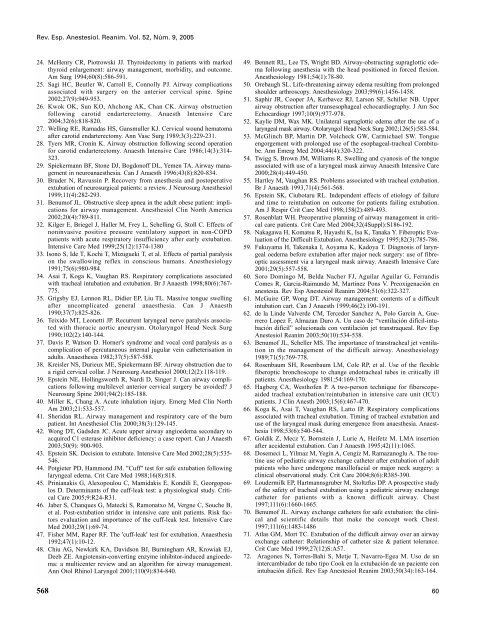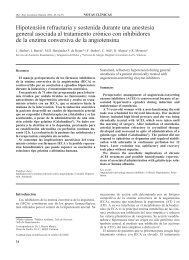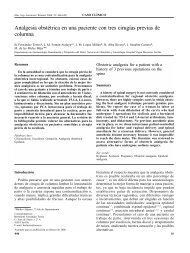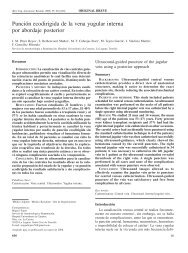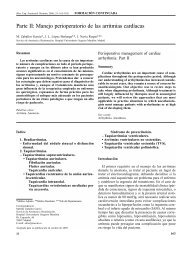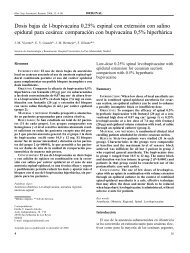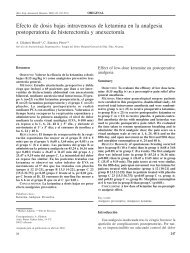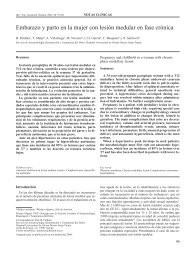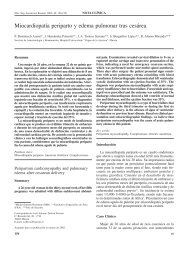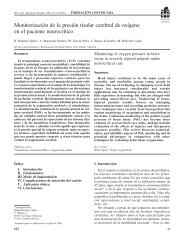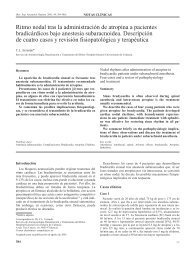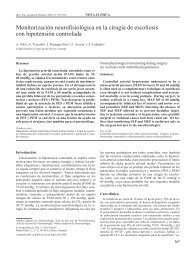La extubación de la vía aérea difícil - Sociedad Española de ...
La extubación de la vía aérea difícil - Sociedad Española de ...
La extubación de la vía aérea difícil - Sociedad Española de ...
You also want an ePaper? Increase the reach of your titles
YUMPU automatically turns print PDFs into web optimized ePapers that Google loves.
Rev. Esp. Anestesiol. Reanim. Vol. 52, Núm. 9, 2005<br />
24. McHenry CR, Piotrowski JJ. Thyroi<strong>de</strong>ctomy in patients with marked<br />
thyroid en<strong>la</strong>rgement: airway management, morbidity, and outcome.<br />
Am Surg 1994;60(8):586-591.<br />
25. Sagi HC, Beutler W, Carroll E, Connolly PJ. Airway complications<br />
associated with surgery on the anterior cervical spine. Spine<br />
2002;27(9):949-953.<br />
26. Kwok OK, Sun KO, Ahchong AK, Chan CK. Airway obstruction<br />
following carotid endarterectomy. Anaesth Intensive Care<br />
2004;32(6):818-820.<br />
27. Welling RE, Ramadas HS, Gansmuller KJ. Cervical wound hematoma<br />
after carotid endarterectomy. Ann Vasc Surg 1989;3(3):229-231.<br />
28. Tyers MR, Cronin K. Airway obstruction following second operation<br />
for carotid endarterectomy. Anaesth Intensive Care 1986;14(3):314-<br />
323.<br />
29. Spiekermann BF, Stone DJ, Bogdonoff DL, Yemen TA. Airway management<br />
in neuroanaesthesia. Can J Anaesth 1996;43(8):820-834.<br />
30. Bru<strong>de</strong>r N, Ravussin P. Recovery from anesthesia and postoperative<br />
extubation of neurosurgical patients: a review. J Neurosurg Anesthesiol<br />
1999;11(4):282-293.<br />
31. Benumof JL. Obstructive sleep apnea in the adult obese patient: implications<br />
for airway management. Anesthesiol Clin North America<br />
2002;20(4):789-811.<br />
32. Kilger E, Briegel J, Haller M, Frey L, Schelling G, Stoll C. Effects of<br />
noninvasive positive pressure venti<strong>la</strong>tory support in non-COPD<br />
patients with acute respiratory insufficiency after early extubation.<br />
Intensive Care Med 1999;25(12):1374-1380<br />
33. Isono S, I<strong>de</strong> T, Kochi T, Mizugueki T, et al. Effects of partial paralysis<br />
on the swallowing reflex in conscious humans. Anesthesiology<br />
1991;75(6):980-984.<br />
34. Asai T, Koga K, Vaughan RS. Respiratory complications associated<br />
with tracheal intubation and extubation. Br J Anaesth 1998;80(6):767-<br />
775.<br />
35. Grigsby EJ, Lennon RL, Didier EP, Liu TL. Massive tongue swelling<br />
after uncomplicated general anaesthesia. Can J Anaesth<br />
1990;37(7):825-826.<br />
36. Teixido MT, Leonetti JP. Recurrent <strong>la</strong>ryngeal nerve paralysis associated<br />
with thoracic aortic aneurysm. Oto<strong>la</strong>ryngol Head Neck Surg<br />
1990;102(2):140-144.<br />
37. Davis P, Watson D. Horner's syndrome and vocal cord paralysis as a<br />
complication of percutaneous internal jugu<strong>la</strong>r vein catheterisation in<br />
adults. Anaesthesia 1982;37(5):587-588.<br />
38. Kreisler NS, Durieux ME, Spiekermann BF. Airway obstruction due to<br />
a rigid cervical col<strong>la</strong>r. J Neurosurg Anesthesiol 2000;12(2):118-119.<br />
39. Epstein NE, Hollingsworth R, Nardi D, Singer J. Can airway complications<br />
following multilevel anterior cervical surgery be avoi<strong>de</strong>d? J<br />
Neurosurg Spine 2001;94(2):185-188.<br />
40. Miller K, Chang A. Acute inha<strong>la</strong>tion injury. Emerg Med Clin North<br />
Am 2003;21:533-557.<br />
41. Sheridan RL. Airway management and respiratory care of the burn<br />
patient. Int Anesthesiol Clin 2000;38(3):129-145.<br />
42. Wong DT, Gads<strong>de</strong>n JC. Acute upper airway angioe<strong>de</strong>ma secondary to<br />
acquired C1 esterase inhibitor <strong>de</strong>ficiency: a case report. Can J Anaesth<br />
2003;50(9): 900-903.<br />
43. Epstein SK. Decision to extubate. Intensive Care Med 2002;28(5):535-<br />
546.<br />
44. Potgieter PD, Hammond JM. "Cuff" test for safe extubation following<br />
<strong>la</strong>ryngeal e<strong>de</strong>ma. Crit Care Med 1988;16(8):818.<br />
45. Prinianakis G, Alexopoulou C, Mamidakis E, Kondili E, Georgopoulos<br />
D. Determinants of the cuff-leak test: a physiological study. Critical<br />
Care 2005;9:R24-R31.<br />
46. Jaber S, Chanques G, Matecki S, Ramonatxo M, Vergne C, Souche B,<br />
et al. Post-extubation stridor in intensive care unit patients. Risk factors<br />
evaluation and importance of the cuff-leak test. Intensive Care<br />
Med 2003;29(1):69-74.<br />
47. Fisher MM, Raper RF. The 'cuff-leak' test for extubation. Anaesthesia<br />
1992;47(1):10-12.<br />
48. Chiu AG, Newkirk KA, Davidson BJ, Burningham AR, Krowiak EJ,<br />
Deeb ZE. Angiotensin-converting enzyme inhibitor-induced angioe<strong>de</strong>ma:<br />
a multicenter review and an algorithm for airway management.<br />
Ann Otol Rhinol <strong>La</strong>ryngol 2001;110(9):834-840.<br />
49. Bennett RL, Lee TS, Wright BD. Airway-obstructing supraglottic e<strong>de</strong>ma<br />
following anesthesia with the head positioned in forced flexion.<br />
Anesthesiology 1981;54(1):78-80.<br />
50. Orebaugh SL. Life-threatening airway e<strong>de</strong>ma resulting from prolonged<br />
shoul<strong>de</strong>r arthroscopy. Anesthesiology 2003;99(6):1456-1458.<br />
51. Saphir JR, Cooper JA, Kerbavez RJ, <strong>La</strong>rson SF, Schiller NB. Upper<br />
airway obstruction after transesophageal echocardiography. J Am Soc<br />
Echocardiogr 1997;10(9):977-978.<br />
52. Kaylie DM, Wax MK. Uni<strong>la</strong>teral supraglottic e<strong>de</strong>ma after the use of a<br />
<strong>la</strong>ryngeal mask airway. Oto<strong>la</strong>ryngol Head Neck Surg 2002;126(5):583-584.<br />
53. McGlinch BP, Martin DP, Volcheck GW, Carmichael SW. Tongue<br />
engorgement with prolonged use of the esophageal-tracheal Combitube.<br />
Ann Emerg Med 2004;44(4):320-322.<br />
54. Twigg S, Brown JM, Williams R. Swelling and cyanosis of the tongue<br />
associated with use of a <strong>la</strong>ryngeal mask airway Anaesth Intensive Care<br />
2000;28(4):449-450.<br />
55. Hartley M, Vaughan RS. Problems associated with tracheal extubation.<br />
Br J Anaesth 1993,71(4):561-568.<br />
56. Epstein SK, Ciubotaru RL. In<strong>de</strong>pen<strong>de</strong>nt effects of etiology of failure<br />
and time to reintubation on outcome for patients failing extubation.<br />
Am J Respir Crit Care Med 1998;158(2):489-493.<br />
57. Rosenb<strong>la</strong>tt WH. Preoperative p<strong>la</strong>nning of airway management in critical<br />
care patients. Crit Care Med 2004;32(4Suppl):S186-192.<br />
58. Nakagawa H, Komatsu R, Hayashi K, Isa K, Tanaka Y. Fiberoptic Evaluation<br />
of the Difficult Extubation. Anesthesiology 1995;82(3):785-786.<br />
59. Fukuyama H, Takenaka I, Aoyama K, Kadoya T. Diagnosis of <strong>la</strong>ryngeal<br />
oe<strong>de</strong>ma before extubation after major neck surgery: use of fibreoptic<br />
assessment via a <strong>la</strong>ryngeal mask airway. Anaesth Intensive Care<br />
2001;29(5):557-558.<br />
60. Soro Domingo M, Belda Nacher FJ, Agui<strong>la</strong>r Agui<strong>la</strong>r G, Ferrandis<br />
Comes R, Garcia-Raimundo M, Martinez Pons V. Preoxigenación en<br />
anestesia. Rev Esp Anestesiol Reanim 2004;51(6):322-327.<br />
61. McGuire GP, Wong DT. Airway management: contents of a difficult<br />
intubation cart. Can J Anaesth 1999;46(2):190-191.<br />
62. <strong>de</strong> <strong>la</strong> Lin<strong>de</strong> Valver<strong>de</strong> CM, Tercedor Sanchez A, Polo Garcin A, Guerrero<br />
Lopez F, Almazan Duro A. Un caso <strong>de</strong> “venti<strong>la</strong>ción <strong>difícil</strong>-intubación<br />
<strong>difícil</strong>” solucionada con venti<strong>la</strong>ción jet transtraqueal. Rev Esp<br />
Anestesiol Reanim 2003;50(10):534-538.<br />
63. Benumof JL, Scheller MS. The importance of transtracheal jet venti<strong>la</strong>tion<br />
in the management of the difficult airway. Anesthesiology<br />
1989;71(5):769-778.<br />
64. Rosenbaum SH, Rosenbaum LM, Cole RP, et al. Use of the flexible<br />
fiberoptic bronchoscope to change endotracheal tubes in critically ill<br />
patients. Anesthesiology 1981;54:169-170.<br />
65. Hagberg CA, Westhofen P. A two-person technique for fiberscopeai<strong>de</strong>d<br />
tracheal extubation/reintubation in intensive care unit (ICU)<br />
patients. J Clin Anesth 2003;15(6):467-470.<br />
66. Koga K, Asai T, Vaughan RS, <strong>La</strong>tto IP. Respiratory complications<br />
associated with tracheal extubation. Timing of tracheal extubation and<br />
use of the <strong>la</strong>ryngeal mask during emergence from anaesthesia. Anaesthesia<br />
1998;53(6):540-544.<br />
67. Goldik Z, Mecz Y, Bornstein J, Lurie A, Heifetz M. LMA insertion<br />
after acci<strong>de</strong>ntal extubation. Can J Anaesth 1995;42(11):1065.<br />
68. Dosemeci L, Yilmaz M, Yegin A, Cengiz M, Ramazanoglu A. The routine<br />
use of pediatric airway exchange catheter after extubation of adult<br />
patients who have un<strong>de</strong>rgone maxillofacial or major neck surgery: a<br />
clinical observational study. Crit Care 2004;8(6):R385-390.<br />
69. Lou<strong>de</strong>rmilk EP, Hartmannsgruber M, Stoltzfus DP. A prospective study<br />
of the safety of tracheal extubation using a pediatric airway exchange<br />
catheter for patients with a known difficult airway. Chest<br />
1997;111(6):1660-1665.<br />
70. Benumof JL. Airway exchange catheters for safe extubation: the clinical<br />
and scientific <strong>de</strong>tails that make the concept work Chest.<br />
1997;111(6):1483-1486<br />
71. At<strong>la</strong>s GM, Mort TC. Extubation of the difficult airway over an airway<br />
exchange catheter: Re<strong>la</strong>tionship of catheter size & patient tolerance.<br />
Crit Care Med 1999;27(12)S:A57.<br />
72. Aragones N, Torres-Bahi S, Metje T, Navarro-Egea M. Uso <strong>de</strong> un<br />
intercambiador <strong>de</strong> tubo tipo Cook en <strong>la</strong> <strong>extubación</strong> <strong>de</strong> un paciente con<br />
intubación <strong>difícil</strong>. Rev Esp Anestesiol Reanim 2003;50(34):163-164.<br />
568 60


